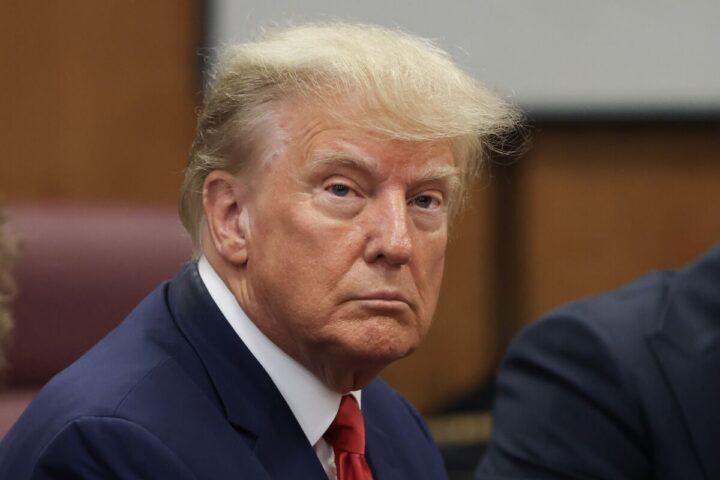On October 20th, Bitcoin made a significant move, surging to $30,000 as Wall Street opened its doors. Analysts were closely monitoring the weekly closing price to gauge the strength of this rally.
BTC’s price reached a two-month high of $30,233 on Bitstamp, maintaining its strength during the Asian trading session.
However, as of the time of writing, it experienced a slight dip, dropping just below $29,500.
The ongoing volatility in the market had experts emphasizing the importance of a strong weekly candle close to confirm the sustainability of the rally.
One key metric being watched closely was the 100-week moving average (MA) at $28,627. Keith Alan, co-founder of Material Indicators, emphasized the significance of the weekly candle closing above this level, with subsequent candles staying above it without any downward wicks.
He noted that Bitcoin would need to overcome resistance levels at $30.5k, $31.5k, and ultimately $33k to validate a bull breakout.
Trader Pentoshi identified $28,900 as a critical support level that bulls needed to maintain. Meanwhile, another trader, Skew, suggested that a sweep of late long positions could create an entry opportunity before the upside resumed.
Taking a longer-term perspective, the trading team at Stockmoney Lizards remained optimistic, predicting that the resistance just above $30,000 would soon be breached.
READ MORE:Binance.US Shifts Withdrawal Options, Encourages Users to Convert USD to Crypto
They pointed to a chart fractal comparing BTC/USD in 2023 to its 2020 breakout, suggesting that significant upward movement was imminent.
The approval of the United States’ first Bitcoin spot price exchange-traded fund (ETF) was seen as a potential catalyst for this surge.
In their commentary, Stockmoney Lizards addressed concerns about the timing relative to the 2020 halving event, stating that the current circumstances, including mass adoption and potential ETF approval, would be the driving forces behind Bitcoin’s price movement.
They also mentioned the upcoming block subsidy halving scheduled for April 2024, which could further impact the cryptocurrency landscape.
In conclusion, Bitcoin’s price surged to $30,000 on October 20th, with market participants closely monitoring the weekly candle close to confirm the strength of the rally.
Key support and resistance levels were identified, and traders remained optimistic about the cryptocurrency’s future, especially in the context of potential ETF approval and upcoming halving events.
Other Stories:
Ripple Fuels Speculation of Potential IPO Amidst Legal Battles
Coinbase’s Chief Legal Officer Urges Cryptosphere to Oppose Proposed U.S. Tax Regulations
Explosive Growth in Ethereum Liquid Staking Derivatives Finance (LSDFi) Ecosystem
Bitcoin’s price is poised to reach $128,000 or even higher by the close of 2025, according to a variety of analytical models.
On October 17, CryptoCon, a well-known trader and analyst, posted his latest Bitcoin price predictions on the X social media platform. He established a two-year target of approximately $130,000.
Although opinions on how Bitcoin’s price will respond to the upcoming block subsidy halving in the next year differ among market participants, CryptoCon remains bullish about the long-term outlook.
In his updates on various models tracking Bitcoin price cycles and their peaks and troughs, he emphasized that the $130,000 mark was rapidly becoming a significant target.
He summarized, “I’ve been conducting extensive experiments on Bitcoin cycle tops lately, and I consistently see a price of around $130,000.”
Additionally, he presented a chart highlighting “early” peaks in each price cycle, along with the actual cycle top that establishes a new all-time high.
These early peaks typically occur about three weeks before or after July 9, while the new all-time highs occur about three weeks before or after November 28.
READ MORE:Regulated Crypto Casinos May Accelerate Web3 Adoption
CryptoCon derived the timing for these events by plotting simple diagonal trendlines from the first early peak, revealing a price of around $138,000 for the next cycle top.
While acknowledging the possibility of lower prices, he stated, “The signs are aligning for Bitcoin to reach $130,000 in this cycle.”
According to model timing, 2025 is expected to be the year when the next cycle peak occurs, nearly double the previous record set in 2021.
Meanwhile, some well-known Bitcoin market commentators are guided by the four-year halving cycles. Rekt Capital, a popular trader and analyst, suggests that the year 2023, just before the halving, might witness some new local lows before the bull market regains full momentum.
He previously warned about the potential for a double-top structure based on the $32,000 highs seen earlier this year, which could fuel a prolonged BTC price decline.
Rekt Capital remarked, “At this same point in the cycle (~180 days before the Halving)… BTC retraced -25% in 2015/2016 and -38% in 2019.”
He noted the uncertainty of whether history would repeat or if 2023 would bring something entirely different, but emphasized that any new lows should be viewed as opportunities for re-accumulation.
Other Stories:
Proposed Settlement Offers Hope of Over 90% Asset Recovery for FTX and FTX.US Customers
Australian Government Proposes New Regulations for Cryptocurrency Exchanges
Ethereum Co-Founder Vitalik Buterin Clarifies $15 Million USDC Transaction
The United States government has quietly amassed a substantial Bitcoin holding, making it one of the largest cryptocurrency holders globally.
Recent data analysis conducted by the crypto firm 21.co reveals that the U.S. government currently possesses approximately 194,188 BTC, with an estimated value of $5.3 billion.
It’s important to note that these figures are considered conservative estimates based on publicly available information.
The analysis focused on tracking the movement of Bitcoin within U.S. government wallets associated with three significant seizures of the cryptocurrency since 2020.
These seizures include the Silk Road’s confiscation of 69,369 BTC in November 2020, the Bitfinex Hack’s seizure of 94,643 BTC in January 2022, and the James Zhong seizure of 51,326 BTC in March 2022.
The U.S. government has taken stringent measures to secure its Bitcoin holdings, primarily storing them offline in encrypted hardware wallets.
These wallets are safeguarded within the premises of the Justice Department and the Internal Revenue Service, ensuring their protection against potential cyber threats.
It’s important to clarify that seized assets don’t automatically become the property of the government.
The U.S. Marshals Service, the primary agency responsible for managing seized property, gains possession of the seized Bitcoin only after a court issues a definitive forfeiture judgment.
READ MORE:Grayscale Bitcoin Trust (GBTC) Discount Narrows to Two-Year Low Amid Spot Bitcoin ETF Optimism
Following this, the government can choose to sell a portion of the seized Bitcoin through an auction system based on court liquidation orders.
While auctions have been the traditional method for the government to dispose of seized Bitcoin, recent years have seen a shift towards utilizing cryptocurrency exchanges for these sales.
One notable example occurred in March of this year when the U.S. government auctioned 9,118 BTC on Coinbase, as confirmed through public filings.
This strategic approach to handling seized cryptocurrency reflects the evolving landscape of digital assets within the U.S. government.
Notably, it contrasts with the earlier instance in 2014 when billionaire Tim Draper acquired 30,000 BTC through U.S. government auctions, emphasizing how the government’s tactics have evolved over time.
As the U.S. government continues to navigate the complexities of cryptocurrency holdings, its substantial Bitcoin reserves stand as a testament to the ever-increasing importance of digital assets in the global financial landscape.
This development underscores the need for transparency and accountability in managing such holdings, ensuring they are utilized to benefit the American people and uphold the principles of responsible financial management.
Other Stories:
California Governor Approves Stricter Cryptocurrency Regulations for 2025
Latin America’s Strong Preference for Centralized Exchanges in Crypto Trading
FTX Estate’s Bold Solana Staking Signals Strong Crypto Commitment
Grayscale Bitcoin Trust (GBTC) is currently experiencing its lowest discount in almost two years, with its discount to Bitcoin’s net asset value (NAV) narrowing to 15.87% as of October 13, according to data from YCharts.
This metric measures how much a mutual fund or ETF is trading below its actual net asset value, offering insights into its true market value.
The narrowing of GBTC’s discount began when financial giants like BlackRock and several other institutions filed applications for spot Bitcoin ETFs in mid-June.
1From a high of 44% on June 15, the discount steadily decreased to 26.7% by July 5. Since then, it has continued to shrink.
The last time GBTC’s discount was at a similar level was in early December 2021, shortly after Bitcoin reached its all-time high price of $69,000 in November, as reported by CoinGecko.
Many in the cryptocurrency community, including Bitcoin advocate Oliver Velez, speculate that the market is factoring in the approval of spot Bitcoin ETFs by the end of the year.
READ MORE:Secret Audio Exposes Alameda Research’s Misuse of FTX User Funds, Unveiling Shocking Details
Lyle Pratt, a cryptocurrency investor, believes that GBTC’s discount will continue to decrease over the next week or two as spot Bitcoin ETFs approach regulatory approval.
Recent reports suggest that the United States Securities and Exchange Commission (SEC) chose not to appeal the Grayscale decision on October 13.
This development has led Bloomberg ETF analyst James Seyffart to describe spot Bitcoin ETF approvals as a “done deal.”
On October 15, Grayscale issued a statement indicating that the SEC’s 45-day period for seeking a rehearing had elapsed.
Consequently, the court is expected to issue its “final mandate” within the next seven calendar days.
Grayscale expressed its operational readiness to convert GBTC into an ETF upon SEC approval and pledged to share further details as soon as possible.
Cointelegraph attempted to reach out to Grayscale for additional comments but had not received an immediate response at the time of reporting.
Other Stories:
MetaMask Temporarily Removed from Apple’s App Store
Bitcoin Holds Steady at $26,800 as SEC’s Grayscale Decision Looms
SEC Opts Not to Appeal Ruling Favoring Grayscale’s Bitcoin ETF Application
California Governor Gavin Newsom has given the green light to a new cryptocurrency bill that will usher in stricter regulations for businesses engaged in cryptocurrency activities, slated to take effect in July 2025.
In an announcement made on October 13th, Newsom revealed that the legislation, officially titled the Digital Financial Assets Law, will necessitate both individuals and companies to obtain a Department of Financial Protection and Innovation (DFPI) license if they intend to participate in digital asset-related business activities.
This move builds upon California’s existing money transmission laws, which already prohibit financial and transfer services from operating without proper licensing from the DFPI commissioner.
The Digital Financial Assets Law goes a step further by empowering the DFPI to impose robust audit requirements on cryptocurrency firms and compel them to maintain detailed financial records.
According to the bill, licensees must maintain records, including a comprehensive general ledger updated at least monthly, listing all assets, liabilities, capital, income, and expenses for a minimum of five years following each activity.
The legislation also underlines that non-compliance will result in enforcement actions against offending firms.
READ MORE: Secret Audio Exposes Alameda Research’s Misuse of FTX User Funds, Unveiling Shocking Details
Interestingly, in a similar timeframe in 2022, Governor Newsom declined to endorse a comparable bill designed to establish a regulatory framework for digital assets within California.
Even though the bill had garnered unanimous support in the California State Assembly, Newsom opted not to sign it, explaining that it lacked the adaptability needed to keep pace with the swiftly evolving cryptocurrency landscape.
Instead, he expressed his preference for waiting until federal regulations were in place before collaborating with the legislature to formulate comprehensive cryptocurrency licensing measures.
This development aligns with broader discussions within the United States about extending existing financial regulations, like the Electronic Fund Transfer Act, to encompass cryptocurrencies as a means of combating fraudulent transfers.
Rohit Chopra, the director of the Consumer Financial Protection Bureau, recently voiced his intention to grant such authorization, aiming to minimize the risks associated with errors, hacks, and unauthorized cryptocurrency transfers.
In summary, California’s Digital Financial Assets Law, set to take effect in July 2025, represents a significant step forward in regulating cryptocurrency activities, requiring licensing for individuals and businesses and introducing stringent audit and record-keeping requirements to ensure compliance with financial regulations.
Other Stories:
SEC Opts Not to Appeal Ruling Favoring Grayscale’s Bitcoin ETF Application
Bitcoin Holds Steady at $26,800 as SEC’s Grayscale Decision Looms
The United States Securities and Exchange Commission (SEC) has reportedly opted not to appeal a recent court ruling in favor of Grayscale Investments.
The decision stems from the U.S. Court of Appeals for the District of Columbia Circuit, which directed the SEC to review Grayscale’s application for a spot Bitcoin exchange-traded fund (ETF).
This development was disclosed in an October 13 report by Reuters, citing an insider source. Bloomberg analysts, too, anticipate that the SEC will refrain from taking the matter to the Supreme Court, although this doesn’t guarantee automatic approval for Grayscale’s ETF application.
If these reports hold true, the SEC is obligated to comply with the court’s August order, requiring a thorough evaluation of Grayscale’s request to transform its Grayscale Bitcoin Trust into a spot Bitcoin ETF. Reuters anticipates that the appeals court will soon provide a detailed mandate outlining how the SEC should execute this ruling.
In response to these unfolding events, Bloomberg ETF analyst James Seyffart expressed his perspective via X (formerly Twitter), suggesting that the SEC is unlikely to appeal further.
READ MORE: Former Engineer Exposes Multi-Million Dollar Scams at Alameda Research Amidst FTX Fraud Trial
Seyffart anticipates that discussions between Grayscale and the SEC will commence in the coming week, with the hope of shedding more light on the next steps.
Looking ahead, Seyffart posits that we may learn in the next week or two about the deadline for the SEC to either approve or deny Grayscale’s spot Bitcoin ETF application.
Should the SEC reject the application, Grayscale would retain the option to appeal, potentially prolonging the process.
Approximately seven spot Bitcoin ETF applications currently await the SEC’s decision, indicating substantial interest in this investment vehicle.
In a separate X post on October 13, Seyffart reiterated his belief in a 90% probability of a spot Bitcoin ETF application receiving approval in January 2024, with specific reference to Cathie Wood’s ARK Invest.
Seyffart and Eric Balchunas, Bloomberg’s senior ETF analyst, previously estimated a 75% likelihood of an ETF application gaining approval in 2023, underscoring the growing momentum and expectations surrounding this evolving financial instrument.
Other Stories:
FTX Collapse Tied to Bankman-Fried’s Financial Maneuvers, Reveals Ex-Alameda CEO
Cardano Founder Equates FTX’s Bankman-Fried to Bernie Madoff Amid Controversial Trial
On October 13, Bitcoin (BTC) remained steady around the crucial $26,800 level for a second consecutive day as United States regulators prepared to make a decision in their ongoing battle with crypto investment giant Grayscale.
Data from Cointelegraph Markets Pro and TradingView indicated that Bitcoin’s price exhibited minimal change from the previous day, trading within a narrow range.
Analysts closely monitored several potential catalysts, including the pending decision by the U.S. Securities and Exchange Commission (SEC) regarding the appeal of a court ruling related to its refusal to approve a Bitcoin spot exchange-traded fund (ETF).
Michaël van de Poppe, the founder and CEO of MN Trading, emphasized the significance of the day, stating in a social media post, “Today is an important day with the SEC Appeal on the Grayscale ruling.
If nothing happens, we might be seeing a case where Bitcoin reverses upwards in the coming weeks. I’m positioned long.”
Amidst a week filled with economic data releases that consistently revealed higher-than-expected inflation, macroeconomic data releases were taking a temporary break.
READ MORE: Former Engineer Exposes Multi-Million Dollar Scams at Alameda Research Amidst FTX Fraud Trial
Renowned trader and analyst Credible Crypto expressed cautious optimism about Bitcoin’s future price trajectory, highlighting a pattern of controlled price declines and suggesting that a reversal might occur once certain levels were cleared.
Meanwhile, trader Daan Crypto Trades observed Bitcoin moving within a range defined by two liquidity levels, anticipating a reaction should the spot price reach either boundary.
Trader and analyst Rekt Capital set a price target of $25,000 for Bitcoin if bulls failed to regain lost exponential moving averages (EMAs) during the week.
Leading up to the appeal deadline, Grayscale’s flagship investment fund, the Grayscale Bitcoin Trust (GBTC), continued to perform well.
Grayscale anticipated that the ongoing legal proceedings would result in GBTC becoming a spot ETF. An early victory for the company in Q2 had already boosted its fortunes. ]
On October 11, GBTC reached its narrowest discount to the net asset value (NAV), which equates to the Bitcoin spot price, since December 2021.
The discount, technically a negative premium, bottomed out at -16.44% before slightly decreasing, as reported by CoinGlass, a monitoring resource.
Other Stories:
FTX Collapse Tied to Bankman-Fried’s Financial Maneuvers, Reveals Ex-Alameda CEO
Cardano Founder Equates FTX’s Bankman-Fried to Bernie Madoff Amid Controversial Trial
Prominent cryptocurrency advocate, Arthur Hayes, recently voiced his predictions on the future of Bitcoin, global economies, and market behaviors on Impact Theory with Tom Bilyeu.
According to Hayes, by 2026, Bitcoin’s price could soar between $750,000 to $1 million.
Hayes paints a picture of a looming financial crisis, which he believes could be more severe than the Great Depression.
He predicts an unprecedented bull market, impacting stocks, real estate, cryptocurrencies, art, and more.
This surge, he claims, is a result of the U.S. government’s habitual response to economic crises: bailing out, leading to structural issues in the economy.
By continuously resorting to central bank printing, inflation surges and natural market growth-correction cycles are stifled.
“Government interventions, in attempts to save the system, erode parts of the free market every time a financial crisis emerges over the last 80 years,” Hayes argues.
READ MORE:Prosecutors Challenge Defense Over FTX Funds in Bankman-Fried’s High-Profile Trial
Hayes identifies key factors supporting his Bitcoin forecast:
- Mounting Debt and Inflation: Hayes states that escalating government debt, roll-over needs, and waning productivity are only met with money printing. Though this results in bull markets, the fallout is typically rampant inflation. Hayes warns of a ‘massive top’ in 2026, followed by a depression-like scenario.
- U.S. Banking System’s Insolvency: He points to the $7.75 trillion U.S. debt due for roll-over by 2026 and altered dynamics in U.S. bond yield curves. Historically, nations like China and Japan were primary U.S. debt buyers. This has changed, which Hayes believes will intensify U.S. troubles. The U.S. banking system, in Hayes’ view, is effectively bankrupt due to past regulatory actions. Hayes emphasizes the banking system’s inability to buy more debt, given its structural insolvency.
- Attractiveness of Bitcoin as an Investment: As traditional financial systems become more unstable, investors may pivot towards alternative assets like Bitcoin. Hayes says, “In an economy with negative real rates, individuals will seek other assets, including cryptocurrencies.”
Hayes forecasts Bitcoin trading between $25,000 and $30,000 in the near future.
By 2024, he anticipates a potential financial crisis to drive rates near 0% or escalating government expenditure causing investors to hunt for superior returns.
He suggests that the U.S., Europe, and possibly Hong Kong’s approval of a Bitcoin exchange-traded fund, combined with Bitcoin’s halving event, could propel its price to $70,000 by mid-2024.
From this point, he foresees Bitcoin skyrocketing to between $750,000 and $1 million.
However, Hayes also acknowledges a potential 70% to 90% drop in Bitcoin’s price post this bull run, mirroring past trends.
Other Stories:
Hacker Exploits Media Coverage of Bankman-Fried’s Trial to Conceal $400M FTX Heist
EU Mulls Tighter Regulations on Major AI Systems, Mirroring Digital Services Act Approach
Why Developers Should Seriously Consider Building on EOS EVM with v0.6.0 Release
Bitcoin maintained its position around $28,000 as of the Oct. 8 weekly close, with geopolitical tensions capturing the attention of traders.
Recent data from Cointelegraph Markets Pro and TradingView highlighted Bitcoin’s resilience against potential drops over the past weekend.
After briefly dipping to $27,000 on Oct. 6, positive US employment figures—contrasting with Federal Reserve policy changes—aided its recovery.
The main focus for traders in the coming week is the $28,000 resistance.
Skew, a notable trader, emphasized in his analysis on the low timeframe (LTF) of exchange order books that significant buying power is essential to transition the $28,000 from resistance to support.
“The market still perceives $28K as resistance. Breaking it would need substantial buying,” he mentioned to his X (formerly Twitter) followers.
Additionally, he observed perpetual contracts (perps) shorting each LTF bounce at $28,000.
Skew also pointed out Bitcoin’s response to the $28,000 level and the current 200-day moving average (MA) of $28,040 as less than ideal.
Another trader, Daan Crypto Trades, warned against betting on Bitcoin’s price drop, especially if a surge takes place.
READ MORE:Senior Republicans Push Biden Administration to Enhance Semiconductor Export Rules to China
He noted the significance of the $28,000 mark with the Daily/Weekly 200MA at the same position and expressed his hesitancy in shorting any upward deviations.
He further shared, “Historically, weekend breakouts at these points have been resilient against retractions.”
A provided chart showcased the final price for the past week’s CME Bitcoin futures, which could act as a pricing guide for the forthcoming week. Daan added, “The CME price is most effective in a fluctuating environment.
We’re in that scenario, but a strong upward move might change it, making me reluctant to short during a potential weekend surge.”
Additionally, recent events in Israel have raised discussions about geopolitical uncertainties possibly influencing Bitcoin’s pricing in the future.
Among the commentators is Michaël van de Poppe, CEO of MN Trading.
He anticipated a volatile week, suggesting that Bitcoin might approach $30K due to growing global uncertainty.
Van de Poppe had previously predicted Bitcoin surpassing $30,000 in October, a month traditionally favorable for Bitcoin.
Currently, Bitcoin is priced slightly below $28,000, marking a 3.5% increase month-to-date, based on CoinGlass data.
Other Stories:
FTX Co-Founder Testifies: Former CEO’s Alleged Misuse of User Funds
Why Do Over 1,6 Billion People Trust BetFury and BFG?
Elon Musk Faces Scrutiny Over Suspension of XRP Account Amidst SEC Investigation
Bitcoin witnessed reduced volatility on October 6th, with market participants preparing for a potential price drop.
Over the last 24 hours, the BTC/USD price stabilized after a failed attempt to breach the $28,000 mark.
Although the cryptocurrency approached this price level again prior to Wall Street’s opening, there were concerns about potential forthcoming losses.
Prominent trader, Daan Crypto Trades, observed a conflict between two major daily moving averages. He predicted that the outcome of this struggle would dictate Bitcoin’s trend for the rest of October.
He highlighted the ongoing contest between the $27,000 and $28,000 price points.
Additionally, he noted the increasing open interest across exchanges, indicating a potential sequence of short squeezes followed by long squeezes. Daan emphasized the importance of monitoring this price range.
READ MORE: DOJ Asserts Lack of Crypto Regulations Doesn’t Bar Charges Against Former FTX CEO
CoinGlass data indicated minor liquidations in both long and short Bitcoin positions on October 6th. Meanwhile, Material Indicators analyzed the trading patterns of “whales,” or large-volume traders.
The study segmented these traders and found that while some were actively buying and selling, leading to a net increase of $13.8 million in market orders on Binance over a week, others sold assets worth nearly $60 million during the same period.
Material Indicators speculated on the possibility of these sales being linked to the potential liquidation of assets from the now-defunct FTX exchange.
The major takeaway was the surprise not in the price’s failure to increase, but its resilience in not dipping further.
Another trading analyst, Exitpump, postulated a potential liquidity trap below the $27,400 mark, suggesting that Bitcoin’s price often retests resistance levels multiple times before establishing a peak.
In essence, as Bitcoin approached the $28,000 mark, market indicators and expert opinions seemed mixed, with some seeing potential for growth and others predicting setbacks.
Other Stories:
Kazakhstan’s Crypto Mining Industry on the Brink of Collapse as Energy Prices Soar
Bitcoin Holds Steady at $27,500 Amidst US Yield Surges and Dollar Volatility






